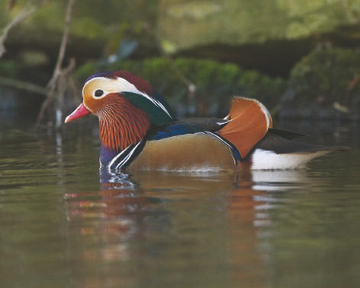
Mandarin Duck © Richard Steel
Most of Mandarins’ early breeding activities take place in the first half of winter. Almost as soon as males emerge from their eclipse plumage in late September or early October, they start displaying, and the majority are paired by the end of the year. Although they are mostly paired, it seems that they are not yet on territory, as many of the breeding tetrads are not occupied in winter; 24 tetrads with breeding season presence did not have birds recorded in winter. This is the same behaviour as is recorded in the core of its British range in southern England, with breeding areas being deserted from late summer until the following spring (BTO Winter Atlas)
As well as a concentration onto fewer sites, many birds shift habitat. In contrast to the situation when breeding, few birds in winter were found on linear watercourses: in 38 tetrads they were recorded on lakes and other waterbodies, with only six on linear watercourses (streams, rivers and large canals). Mandarins have been using our largest waters, and at the other extreme, two birds visited a garden pond at Capenhurst (SJ37R). They are not normally an estuarine duck, but a male was swimming with drake Mallards at high tide on the River Mersey near Mount Manisty (SJ37Z) on 24 November 2004. They especially like to feed on nuts, particularly acorns, chestnuts and beech mast.
This species has not been studied in Cheshire and Wirral, and no detail is known of their movements. It is described as ‘rather sedentary in nature’ but clearly makes local seasonal movements (Brown & Grice 2005). At a site in Berkshire, no more than 30 birds were seen at a time on a lake, yet over 500 birds were ringed there in a two-year period (Davies 1988). Obviously there must be some dispersal to enable them to colonise new sites and, as an extreme, a bird ringed in Britain has been recovered near St Petersburg in Russia, perhaps having been caught up in a return movement with other migratory species (Migration Atlas).
Mandarins do not usually congregate in large flocks. Gatherings of ten birds or more were found in the area south of Chester from Eaton to Churton (SJ45D, SJ45E and SJ46A), including the largest flock counted in this Atlas period, 32 birds on a fishpond on 13 January 2005; near Bickerton (SJ55C), where 10 males and 8 females were on a pond with many dead trees; at Little Budworth (SJ56X); and on Trentabank Reservoir (SJ97Q). The largest winter flock ever in the county appears to have been 63 birds at Aldford Brook on 17 December 2001, when all the lakes were frozen.
This Atlas has given us the best picture yet of Mandarins in Cheshire and Wirral, but many accounts of the species emphasise its secretive nature, so they may well be under-recorded.
Sponsored by Chester and District Ornithological Society

